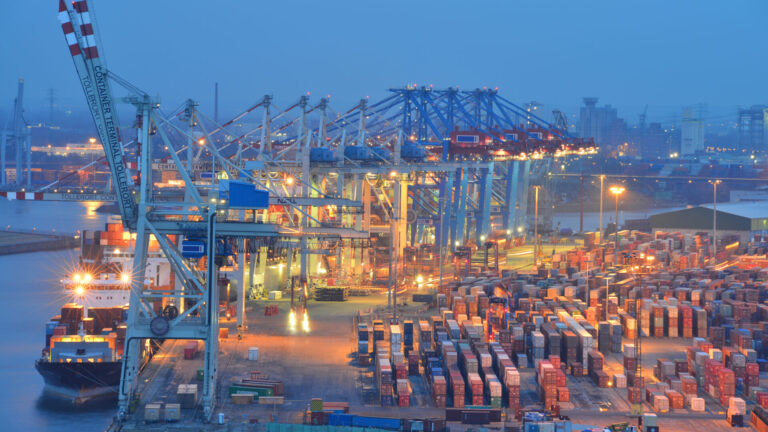
Process Mining and Product Mining at the AWK
Rothbaum will present a new process mining app and use cases for product mining at…

NEWs
The current economic situation is tense and poses major challenges for industrial companies in particular. In the current issue of the business magazine Markets International , our Managing Partner and Head of Business Unit Supply Chain, Dr. Kai Philipp Bauer, talks to Achim Haug from Germany Trade & Invest about current economic policy developments and takes a multi-layered look at resilience and future viability in uncertain times. The special article on “Defying the crisis” brings together perspectives and experiences from various industries and derives six strategies as recommendations for successfully dealing with the crisis.
What are currently the biggest challenges for SMEs in an international environment?
The decline in globalization is fundamentally a problem for the business model of German SMEs. The USA is imposing tariffs and other economic areas are also raising their barriers. The short-term announcements in particular are poison for German SMEs, as investments are planned and made for the long term
. In addition, sales in China are becoming more difficult and Chinese competition is attacking more and more segments and markets. The isolation of the USA will increase the pressure from Chinese goods on the European market.
What advice do you have for companies dealing with the situation in the USA?
Companies should not act hastily. First of all, they need to analyze the developments carefully and take precautions. At an operational level, companies should expand their expertise in customs and transportation
in order to implement the new regulations – in the USA, but also in Europe and China – in the best possible way for their benefit. In addition, existing supply contracts should be checked for customs costs and new contracts should be designed accordingly. Building on this, companies should intensify their risk management and run through corresponding scenarios in order to design the necessary adjustments in procurement and sales.
And at a strategic level?
At a strategic level, companies should develop plans to localize more value creation in the USA. This can be done by establishing and expanding their own locations, but also through cooperation partners or joint ventures. Similarly, procurement strategies should be reconsidered in order to diversify the customs risks of China-heavy procurement, for example. Both of these measures are aimed at being able to serve the USA more locally-for-locally in the future.
Local-for-local strategies offer immense advantages
Dr.-Ing. Kai Philipp Bauer, Senior Manager
They urgently need to develop strategies for dealing with uncertainties. The first step is transparency and foresight, i.e.: where do I have vulnerable supply chains, where are crises imminent? This is not necessarily easy for SMEs, but is becoming an obligation for internationally active companies. They must then actively manage these risks.
You mentioned the local-for-local strategy. What are the advantages?
This means that companies are less affected by trade barriers, can develop locally adapted products and offer competitive prices. Short supply routes also save transportation costs and make supply chains more resilient. With a continental strategy, relatively self-sufficient value chains can be created for the three large economic areas of North America, Asia and Europe. We see this, for example, in industrial automation technology at companies such as Festo, Wago and Turck.
How else can companies improve their competitive position?
For example, companies can exploit cost advantages in Eastern European locations, internationalize supply chains and procure from Asia. And finally, they can also integrate more technological knowledge into foreign locations.
Which locations do you see in Europe?
Poland remains attractive, in B locations the location is still interesting for new productions. In addition, the Western Balkans, with countries such as Albania, North Macedonia and Eastern Croatia.
And what about Asia?
Serving Asian markets from Europe is becoming increasingly difficult, as the cost structures are too different, transportation routes are too long and the products are not adapted to the conditions. Companies therefore need to gear their procurement and production more towards Asia. Locations in South East Asia and India should be the focus here.
A difficult undertaking, especially for smaller companies …
Yes, but they have to accept competition from Chinese products in particular. For many companies, this means continuing to be active in China. However, the decoupling remains a challenge not only in terms of trade, but also in terms of data traffic, standards and capital movements. China has put regulations in place here that make it necessary to have its own structures in the country.

Business Unit Manager Supply Chain
Do you have any questions about the interview or would you like to talk to us personally about this topic? Then please send me a message and I will get back to you as soon as possible.
You need to load content from reCAPTCHA to submit the form. Please note that doing so will share data with third-party providers.
More InformationYou are currently viewing a placeholder content from Turnstile. To access the actual content, click the button below. Please note that doing so will share data with third-party providers.
More InformationYou are currently viewing a placeholder content from Facebook. To access the actual content, click the button below. Please note that doing so will share data with third-party providers.
More InformationYou are currently viewing a placeholder content from Instagram. To access the actual content, click the button below. Please note that doing so will share data with third-party providers.
More Information